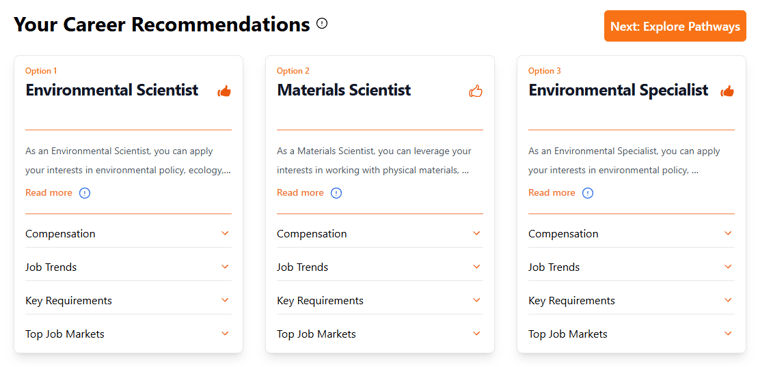Choosing a career and selecting a college major are critical decisions that shape students’...
Understanding the Career and Academic Exploration Assessment - A Dynamic Approach to Career Discovery and Academic Planning
Executive Summary
The Advisor AI Career and Academic Exploration Assessment represents a significant advancement in career guidance tools, combining established career development theories with adaptive AI technology. This assessment helps students make informed decisions about their academic and career paths through personalized, evidence-based recommendations.
Theoretical Foundation
Career Development Theories
- Holland's RIASEC Model (1997): Our assessment incorporates Holland's theory of vocational choice, which suggests that career satisfaction stems from the alignment between personality types and work environments.
- Super's Developmental Self-Concept Theory (1990): The assessment acknowledges career choice as a developmental process, recognizing that students' self-concepts evolve through exploration and experience.
- Social Cognitive Career Theory (Lent, Brown, & Hackett, 1994): Questions are designed to assess self-efficacy beliefs, outcome expectations, and personal goals, which are crucial factors in career decision-making.
Career Clusters Framework
- National Career Clusters Framework: The assessment aligns with the 16 Career Clusters® developed by Advance CTE, which has been the leading framework for organizing and delivering CTE since 1996. Our adapted framework focuses on ten primary clusters with demonstrated labor market demand and growth potential.
- O*NET Career Clusters Research: Incorporates the comprehensive occupational research from O*NET (Occupational Information Network), funded by the U.S. Department of Labor, which provides detailed occupational definitions and career cluster frameworks.
Industry Alignment
Results are updated based on:
- Bureau of Labor Statistics projections
- Industry trend reports
- Professional association data
- LinkedIn Workforce Reports

Assessment Structure and Methodology
Multi-Dimensional Approach - The assessment evaluates seven key dimensions:
- Activity Preferences
- Project Role Inclinations
- Impact Motivation
- Environmental Fit
- Task Satisfaction
- Subject Interest
- Problem-Solving Approach
Adaptive Intelligence
- Dynamic Question Pathways: The AI system analyzes response patterns to present relevant career clusters, ensuring personalized exploration.
- Real-Time Industry Alignment: Career suggestions are continuously updated to reflect current market trends and emerging opportunities.
- Personalized Deep-Dive: The exploration concludes with questions that adapt based on selected career clusters, providing targeted exploration of specific fields.
Advantages of AI Integration
- Increased Engagement: Interactive, personalized experience
- Current Relevance: Real-time updates to career information
- Reduced Bias: Standardized analysis of responses
- Scalable Personalization: Individual attention at scale

Assessment Outcomes
Student Benefits
- Clarified Direction: Students receive targeted career suggestions aligned with their interests and abilities
- Informed Decision-Making: Access to current career information and pathways
- Increased Confidence: Better understanding of personal strengths and preferences
- Academic Alignment: Clear connection between career goals and academic choices
Institution Benefits
- Data-Driven Guidance: Evidence-based support for academic advisors
- Improved Retention: Better academic-career alignment leads to increased student engagement
- Efficient Resource Allocation: Targeted support based on student needs
- Scalable Support: Ability to provide personalized guidance to large student populations
Conclusion
The Advisor AI Career and Academic Exploration Assessment represents a significant advancement in career guidance tools, combining established theoretical frameworks with modern technology to provide reliable, adaptive, and personalized career guidance for students.
.jpg?width=300&height=150&name=Logo-Black%20(1).jpg)



